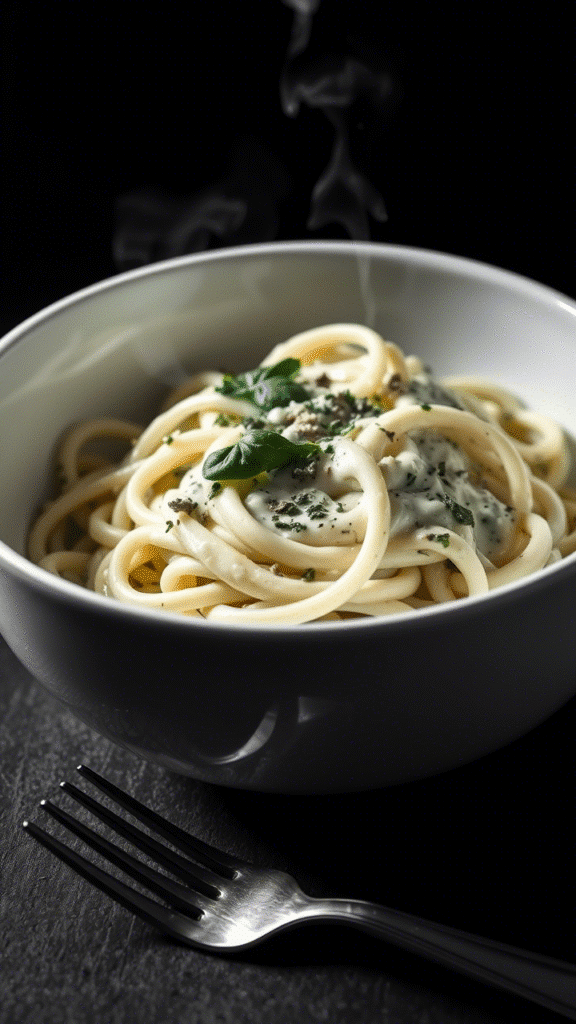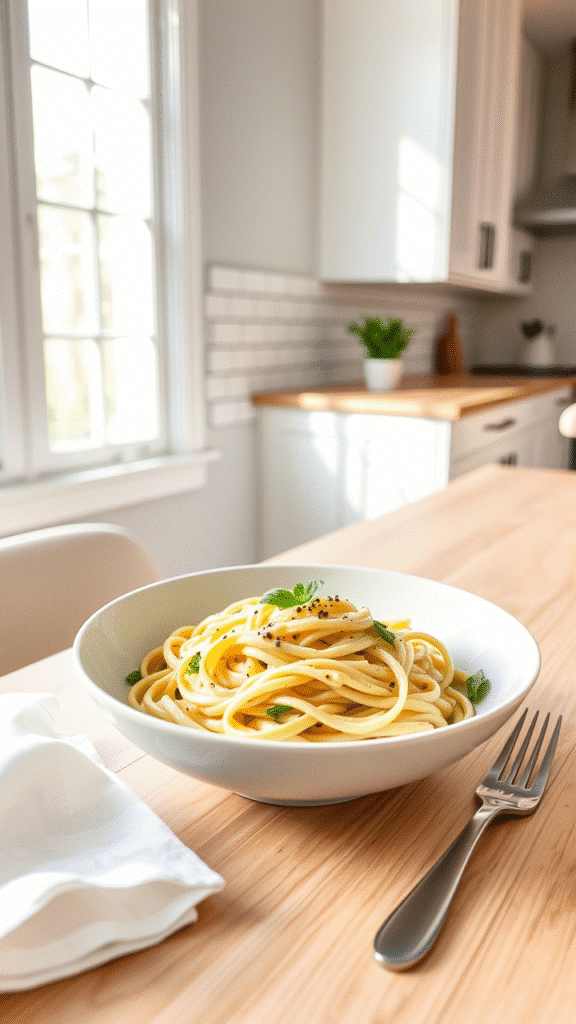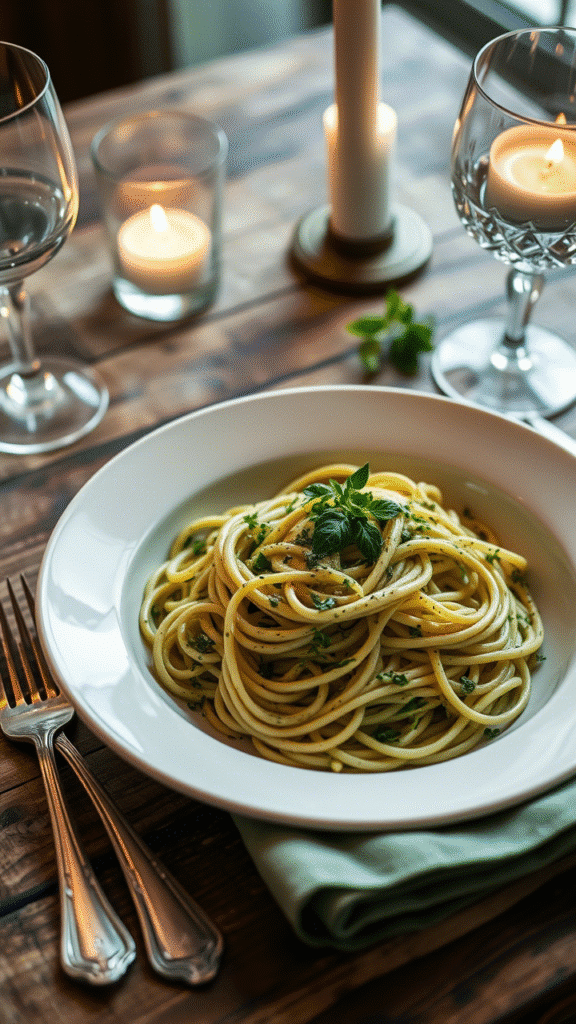Three years ago, I watched a seasoned line cook at a high-end Italian restaurant completely transform a simple pasta dish with nothing more than a handful of herbs and a broken blender. What emerged wasn’t just another green sauce—it was something that made the entire kitchen stop and take notice. That dish? Green Goddess Pasta, and it’s quietly revolutionizing how we think about herb-forward cooking.
This isn’t your grandmother’s pesto, nor is it some trendy social media creation destined to fade. Green Goddess Pasta represents a sophisticated marriage of California’s iconic Green Goddess dressing with Italian pasta traditions, creating something entirely new yet deeply familiar. The sauce combines the creamy richness of traditional goddess dressing with the bright, herbaceous complexity that makes pasta sing.
What makes this dish truly special lies in its technique—the way multiple herbs are layered to create depth rather than just “green flavor.” Unlike pesto, which relies heavily on basil, Green Goddess pasta sauce builds complexity through a careful balance of parsley, chives, tarragon, and sometimes dill. The result is a sauce that’s both comforting and sophisticated, familiar yet surprising.
Understanding the Green Goddess Legacy
The original Green Goddess dressing was born in San Francisco’s Palace Hotel in the 1920s, created to honor actor George Arliss and his play “The Green Goddess.” Chef Philip Roemer’s creation combined mayonnaise, herbs, anchovies, and vinegar into something that became a California staple.

Fast-forward nearly a century, and innovative chefs began adapting this classic into pasta applications. The transformation required rethinking the entire flavor profile—what works as a salad dressing doesn’t automatically translate to hot pasta. The sauce needed body, the herbs required different preparation, and the acid balance had to shift dramatically.
Modern Green Goddess pasta represents this evolution perfectly. It maintains the spirit of the original while embracing contemporary cooking techniques and ingredient sensibilities.
Ingredients & Substitutions
For the Green Goddess Sauce:
- 2 cups fresh flat-leaf parsley, stems removed
- 1/2 cup fresh chives, roughly chopped
- 1/4 cup fresh tarragon leaves
- 2 tablespoons fresh dill fronds
- 4 oil-packed anchovy fillets (or 2 teaspoons anchovy paste)
- 2 garlic cloves, roughly chopped
- 1/3 cup high-quality mayonnaise
- 1/4 cup crème fraîche or sour cream
- 2 tablespoons fresh lemon juice
- 1/4 cup extra-virgin olive oil
- 1/2 teaspoon kosher salt
- Freshly cracked black pepper
For the Pasta:
- 1 pound high-quality pasta (bucatini, linguine, or spaghetti work best)
- 2 tablespoons kosher salt for pasta water
- 1/2 cup reserved pasta cooking water
- 2 tablespoons unsalted butter
- 1/2 cup freshly grated Parmigiano-Reggiano, plus more for serving
Optional Additions:
- 1 cup fresh or frozen peas
- 6 ounces cooked shrimp or chicken
- 1/4 cup toasted pine nuts
The herb selection here isn’t arbitrary—each brings something specific to the party. Parsley provides the backbone, chives add a gentle onion note, tarragon contributes an almost licorice-like sophistication, and dill brings brightness. Don’t skip the tarragon; it’s what separates this from basic herb pastas.
For substitutions, respect the ratios but feel free to adapt. No tarragon? Double the dill. Can’t find chives? Green onion tops work beautifully. The anchovy situation is non-negotiable for authenticity, but vegetarians can substitute with a tablespoon of capers plus a pinch of seaweed flakes for that umami depth.
Mayonnaise quality matters more than you’d think. Cheap mayo will make the sauce taste artificial and overly sweet. Look for brands that list eggs and oil as primary ingredients, avoiding anything with too many stabilizers.
Step-by-Step Instructions

Preparing the Green Goddess Base
Start by blanching your herbs—yes, blanching. This step is crucial and often overlooked. Bring a large pot of salted water to a rolling boil and prepare an ice bath. Drop the parsley, chives, tarragon, and dill into the boiling water for exactly 30 seconds, then immediately transfer to the ice bath.
This blanching serves two purposes: it brightens the herb flavors and helps maintain that vibrant green color that makes the dish so visually striking. Drain the herbs thoroughly and squeeze out excess water using a clean kitchen towel.
In a food processor, combine the blanched herbs with anchovy fillets and garlic. Pulse until roughly chopped—don’t turn it into paste yet. Add the mayonnaise, crème fraîche, and lemon juice, then process until smooth. With the processor running, slowly drizzle in the olive oil until the mixture emulsifies into a beautiful, creamy sauce.
Season with salt and pepper, but taste as you go. The anchovies already provide salt, so you might need less than expected.
Cooking the Pasta
This is where timing becomes everything. Start your pasta water while you’re finishing the sauce—it should be at a vigorous boil by the time your sauce is ready. Use plenty of water and salt it generously; the pasta water should taste like mild seawater.
Drop your pasta into the boiling water and cook until just shy of al dente—about 1-2 minutes less than package directions suggest. You’ll finish cooking it in the sauce, which allows the pasta to absorb flavors while maintaining proper texture.
Reserve at least a cup of pasta cooking water before draining. This starchy liquid is your secret weapon for achieving the perfect sauce consistency.
Bringing It All Together
Here’s where technique separates good cooks from great ones. In a large skillet or wide saucepan, warm about half of your Green Goddess sauce over medium-low heat. Add the drained pasta along with a splash of pasta water.
Toss everything together, adding more pasta water gradually until the sauce coats each strand perfectly. The goal is creamy without being heavy, glossy without being greasy. Add the butter and half the Parmigiano-Reggiano, tossing until melted and incorporated.
If you’re adding peas, toss them in during the last minute. For protein like shrimp or chicken, warm it through at the very end to prevent overcooking.
Cooking Techniques & Science
The magic of Green Goddess pasta lies in understanding emulsification and how different fats behave when heated. The mayonnaise base provides stability, while the olive oil adds richness without heaviness. Crème fraîche contributes tang and helps prevent the sauce from breaking when heated.

Temperature control is critical. Too high heat will cause the mayonnaise to separate, creating an oily, unappetizing mess. Keep everything at medium-low and be patient. The pasta’s residual heat will warm the sauce sufficiently.
The pasta water plays a crucial role beyond just thinning the sauce. Its starch content helps bind everything together, creating that coveted “mantecatura”—the Italian technique of vigorously tossing pasta with sauce and starchy water to create perfect coating.
Blanching the herbs might seem fussy, but it’s based on solid science. The brief hot water treatment breaks down cell walls, making the herbs easier to purée while setting their chlorophyll for better color retention. It also removes some of the raw, grassy notes that can overwhelm the finished dish.
Serving & Pairing Suggestions
Green Goddess pasta deserves thoughtful presentation. Serve it in warmed bowls—cold dishes will make the sauce congeal unappetizingly. A light sprinkle of freshly grated Parmigiano-Reggiano and a few turns of black pepper elevate the visual appeal.
For wine pairings, think crisp and herbaceous. A Sauvignon Blanc from Loire Valley echoes the herb flavors beautifully, while a light Pinot Grigio won’t compete with the delicate sauce. If you prefer red wine, choose something light like Beaujolais or a young Chianti.
Side dishes should complement rather than compete. A simple arugula salad with lemon vinaigrette works wonderfully, as does grilled asparagus or roasted cherry tomatoes. Avoid anything too rich or heavily sauced—let the Green Goddess be the star.
This pasta also works beautifully as a side dish for grilled fish or roasted chicken. The herb-forward flavors make it an excellent bridge between protein and vegetables.
Mastering the Details
Professional kitchens know that consistency comes from understanding your ingredients. Different mayonnaise brands will behave differently when heated. Some separate more easily than others, so always test a small amount first if you’re trying a new brand.
The herb ratios can be adjusted based on availability and preference, but maintain the overall volume. Too few herbs and the sauce loses its character; too many and it becomes bitter. Fresh herbs are non-negotiable—dried herbs will create a muddy, unappetizing sauce.
Storage is tricky with Green Goddess pasta. The sauce will keep in the refrigerator for up to three days, but it may separate slightly. Whisk in a tablespoon of warm pasta water to bring it back together. Leftover pasta can be served cold as a salad, though it’s best enjoyed fresh and warm.
Conclusion
Green Goddess pasta represents everything exciting about modern cooking—it honors tradition while embracing innovation. The technique is accessible enough for home cooks yet sophisticated enough for professional kitchens. What makes this dish truly special isn’t just its vibrant appearance or complex herb flavors, but how it demonstrates that great cooking often comes from thoughtful adaptation rather than wholesale invention.
Master this recipe and you’ll understand something fundamental about sauce-making: balance isn’t just about flavor, it’s about texture, temperature, and timing. The Green Goddess technique opens doors to countless variations—try it with different herb combinations, add roasted vegetables, or use it as a base for other pasta dishes.
Remember that great cooking happens in the details. Blanch those herbs, control your heat, and taste constantly. Your guests will notice the difference, even if they can’t articulate exactly what makes this pasta so special.
Frequently Asked Questions?
Can I make Green Goddess sauce ahead of time?
Absolutely, and it actually improves with a few hours of rest. The flavors meld beautifully overnight in the refrigerator. Just remember to bring it to room temperature before tossing with hot pasta, and you might need to thin it slightly with pasta water or cream.
What if my sauce separates when I heat it?
Don’t panic—this is fixable. Remove the pan from heat immediately and whisk in a tablespoon of cold pasta water or cream. If it’s really broken, transfer everything to a blender and pulse briefly to re-emulsify. Prevention is better than cure, so always keep your heat moderate.
Can I make this dish dairy-free?
Yes, with some modifications. Replace the mayonnaise with a high-quality vegan version, substitute the crème fraîche with cashew cream or coconut cream, and skip the Parmigiano-Reggiano or use a good nutritional yeast. The flavor profile will change, but it’ll still be delicious.
What pasta shapes work best with Green Goddess sauce?
Long, thin pastas like linguine, spaghetti, or bucatini are ideal because they allow the sauce to coat evenly. Avoid chunky shapes like rigatoni or farfalle—the sauce will pool in the crevices rather than coating properly. Angel hair is too delicate and becomes mushy.
How can I make this dish more substantial?
The beauty of Green Goddess pasta is its versatility. Add cooked shrimp, grilled chicken, or salmon for protein. Vegetables like asparagus, peas, or cherry tomatoes work beautifully. For vegetarians, try adding roasted pine nuts, chickpeas, or marinated artichoke hearts. Just remember to add these elements at the right time to maintain their texture and flavor.

Veronica is a passionate food enthusiast with over three years of experience in exploring and writing about diverse cuisines. Her expertise lies in reviewing restaurants, sharing creative recipes, and discovering the latest food trends. As the voice behind FoodieRecap.com, Anju brings fresh perspectives and culinary insights to her audience.
